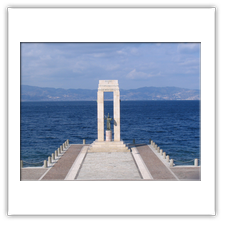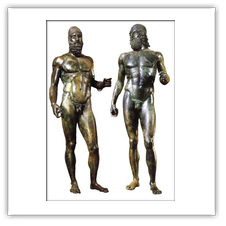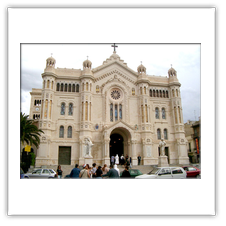Casa di Lina
Reggio Calabria
PLACES TO VISIT
"Reggio is a big garden, one of the best place you can find on the Planet"
(Edward Lear, 1847)
Reggio Calabria (Rrìggiu in Calabria dialect, Righi in Calabria-Greek, Righion in Greek), just known as Reggio in the South of Italy, is the oldest city in the region Calabria. And it is the biggest and most peopled as well. Since the 29th of April of 2009 it is the 10th metropolitan Italian city.
Reggio is situated on "the point of the Boot" (Italy is also called "the big boot") down the Aspromonte Mountains, in a central position on Mediterraneo Sea, it spreads for 23 km in front of the Straits of Messina (where the experts set the meeting between Odysseo and the 2 mytological monters Scilla e Cariddi, descripted by Omero). From there you can enjoy an amazing view of Sicilia, Etna volcano and Eolie Islands.
Reggio is the center of a touristic area, very important for the cultural and storical aspects. It is a university city, in the middle of an agricultural area very rich because of the warm climate. The production is based on olive oil, wine, vegetables and citrus fruits, like the famous "bergamotto", a true symbol of Reggio.
Reggio is also called "the City of Morgan Fairy" because you can see the optical phenomenon of Morgan Fairy . During that strange and suggestive moment, the Sicily coast looks like just few metres far from Reggio and you can see clearly houses, people and cars clearly. Reggio is also known as the "City of the Bronzes" because of the presence of Bronzes of Riace, symbol of the Magna Graecia origins.
Museums in Reggio Calabria
National Museums Of Magna Graecia
One of the most important museums in Italy about this culture.
Civic Gallery
The gallery is situated close the Theater "Francesco Cilea". It has lot of famous Italian artists like Mattia Preti, Luca Giordano, Vincenzo Cannizzaro, Giuseppe Benassai, Ignazio Lavagna Fieschi, Andrea Cefaly, Lionello Spada and Antonello of Messina. Moreover you can find more works of art, dated between the VII and XIX century.
San Paolo Museum
Born in the 30's, it has a rich art collection of Byzantine and Norman elements.
Provincial Planetarium "PYTHAGORAS"
It carries out a didactic activity reguarding Astronomy and Science.
Museum Of Music Instruments
It cares about the improvement and preservation of typical music instruments.
Museum Of Textile Handicraft, Silk And Costum In Calabria
It describes the history of Greek period until 1948. There are lot of machines to work on different kind of materials.
Museum Of Biology And Marine Paleontology
In the collection there are fossils from the deep sea and the hills around the city.
Citrus Fruit Museum
Setted in the " Experimental Station for the industry of the Essences and Citrus Fruits" (SSEA), it has lot of machines to take out the juice and the essence of citrus fruit, like the "bergamotto". There are also a photografic exhibition which illustrates the coltivation, the harvest and the working of "gelsomino" and opium poppy.
Tourism in Reggio Calabria
The Bronzes of Riace, that can be seen at the important "National Museum of Magna Graecia", are one of the main touristic destinations in Reggio. And the "Promenade Falcomatà", a seaside promenade located in the downtown, is a crowded swimming destination and main symbol of the summer "movida". The tourism in Reggio is distributed between the Ionic coast (Costa Jonica), the Tyrrhenian coast (the Costa Viola, Purple Coast) and the Aspromonte mountain behind the city, which contains the natural reserve of Parco Nazionale dell'Aspromonte (National Aspromonte Park), where at 1,400 meters above the sea there is the Gambarie ski resort with a wonderful panoramic view of the Straits of Messina, from the snowy mount Etna to the Aeolian Islands.
Tourist Places To Visit in Reggio Calabria
Promenade "Falcomatà"
In front of the Sea the city, with its historical center, develops between Liberty style architecture and wondreful plants. The Promenade has been considerated by the famous Italian writer Gabriele D'Annunzio "the best Italian kilometre", surely also for the phemomenon of Morgan Fairy, which helps the walking to be special and suggestive.
Bronzes of Riace
One of the symbol of the city, exhibited in "National Museum of Magna Graecia", they are 2 big statues which, in the opinion of experts, represent two eroes of the "Seven against Tebe" mith (maybe Tideo and Anfiarao, or Eteocle and Polinice). The Bronzes are original Greeks from the middle of the V century b.C. and, with the "Auriga of Delphi", they are the only one bronze proof of the master of sculture in Magna Graecia.
Straits Arena (or Teatro Senator Ciccio Franco)
Greek style theater with amazing view of Straits of Messina and Sicily.
Marble Cippus To King Vittorio Emanuele III
Work by Camillo Autore, held in Vittorio Emanuele's III honour. He disembarked there touching for the first time the national territory as King, the 31st of July of 1900. It is situated on "Mole of Porto Salvo", in front of Straits Arena.
Cathedral Of Reggio Calabria
Cathedral of metropolitan archdiocese, is the biggest holy building in Calabria. It has works of art inside, like the big statues on the side of "Stairs of San Paolo and Santo Stefano", by Francesco Jerace, or the Chapel of Blessed Sacrament (national monument), magnificent example of Baroque in Calabria. The walls of the Chapel are covered by marble's inlays taken from the Old principal Church.
Castle Aragonese
very ancient origins, its construction came before the invasion of Goths from Totila in 549 a.C. Strategic defence point of the city, it was under the rule Byzantines, Arabics, Normans, Swabians and Angevins. In 1459 Ferdinando of Aragona added two cylindrical towers which is one of the characteristic of Aragonese castles. Today this place is one of the art exhibition's locations in the city.
Villa Genoese Zerbi
On the Promenade "Falcomatà" there is a Villa in Venetian style of XIV century with decorative elements and very strong chromatisms. One of the most important art center in the city, in Villa Zerbi there are several architecture and art exhisibitions. It is expositive seat of "Biennale of Venezia" in the South of Italy.
Church Of "Ottimati"
Built in the X century, this old Byzantine-Norman church has been destroyed by Turkish invasions and big earthquakes, but rebuilt on its original seat. You can still find the original architecture and art works, supplemented with the works inside the old Norman Church of Santa Maria in Terreti, with a wonderful mosaic flooring and an altar of remarkable value depicting the Annunciation, by Agostino Ciampelli.
Wall Of Greek City
One of the few survived till today, there is a short stroke on the Promenade "Falcomatà" (the archaeological site is called "Greek Wall"), anotherone on "Hill of Angels" and one more on the "Hill of Trabocchetto" (called "Archaelogical Park Trabocchetto"). Now it is possible visiting only the stroke close the Sea (IV century). This is part of the reconstruction made by Dionisio II of Siracusa after that the city has been conquered by his father, Dionisio I. They are composed of two lines of light sandstone blocks. Recently the Wall gave hospitality to the theatrical performances of Classic Epoque.


